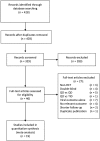Lower pill burden and once-daily antiretroviral treatment regimens for HIV infection: A meta-analysis of randomized controlled trials
- PMID: 24457345
- PMCID: PMC3982838
- DOI: 10.1093/cid/ciu046
Lower pill burden and once-daily antiretroviral treatment regimens for HIV infection: A meta-analysis of randomized controlled trials
Abstract
Background: Contemporary antiretroviral treatment regimens are simpler than in the past, with lower pill burden and once-daily dosing frequency common. We performed a meta-analysis of randomized controlled trials (RCTs) to investigate the impact of pill burden and once-daily vs twice-daily dosing on ART adherence and virological outcomes.
Methods: A literature search of 4 electronic databases through 31 March 2013 was used. RCTs comparing once-daily vs twice-daily ART regimens that also reported on adherence and virological suppression were included. Study design, study population characteristics, intervention, outcome measures, and study quality were extracted. Study quality was rated using the Cochrane risk-of-bias tool.
Results: Nineteen studies met our inclusion criteria (N = 6312 adult patients). Higher pill burden was associated with both lower adherence rates (P = .004) and worse virological suppression (P < .0001) in both once-daily and twice-daily subgroups, although the association with adherence in the once-daily subgroup was not statistically significant. The average adherence was modestly higher in once-daily regimens than twice-daily regimens (weighted mean difference = 2.55%; 95% confidence interval [CI], 1.23 to 3.87; P = .0002). Patients on once-daily regimens did not achieve virological suppression more frequently than patients on twice-daily regimens (relative risk [RR] = 1.01; 95% CI, 0.99 to 1.03; P = .50). Both adherence and viral load suppression decreased over time, but adherence decreased less with once-daily dosing than with twice-daily dosing.
Conclusions: Lower pill burden was associated with both better adherence and virological suppression. Adherence, but not virological suppression, was slightly better with once- vs twice-daily regimens.
Keywords: ART; fixed-dose combination; once-daily; randomized controlled trials; twice-daily.
Figures




Comment in
-
[Antiretroviral treatment regimens: less tablets for a better result].Med Mal Infect. 2014 Sep;44(9):445-6. doi: 10.1016/j.medmal.2014.07.009. Med Mal Infect. 2014. PMID: 25392874 French. No abstract available.
References
-
- Bangsberg DR, Perry S, Charlebois ED, et al. Non-adherence to highly active antiretroviral therapy predicts progression to AIDS. AIDS. 2001;15:1181–3. - PubMed
-
- Nachega JB, Hislop M, Dowdy DW, Chaisson RE, Regensberg L, Maartens G. Adherence to nonnucleoside reverse transcriptase inhibitor-based HIV therapy and virologic outcomes. Ann Intern Med. 2007;146:564–73. - PubMed
-
- Wood E, Hogg RS, Yip B, Harrigan PR, O'Shaughnessy MV, Montaner JS. Effect of medication adherence on survival of HIV-infected adults who start highly active antiretroviral therapy when the CD4+ cell count is 0.200 to 0.350×10(9) cells/L. Ann Intern Med. 2003;139:810–6. - PubMed
-
- Gallant JE, DeJesus E, Arribas JR, et al. Tenofovir DF, emtricitabine, and efavirenz vs. zidovudine, lamivudine, and efavirenz for HIV. New Engl J Med. 2006;354:251–60. - PubMed
Publication types
MeSH terms
Substances
Grants and funding
LinkOut - more resources
Full Text Sources
Other Literature Sources
Medical
Molecular Biology Databases
Miscellaneous

